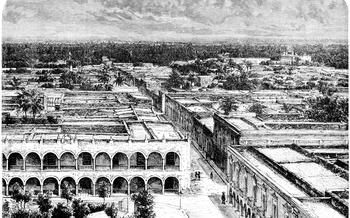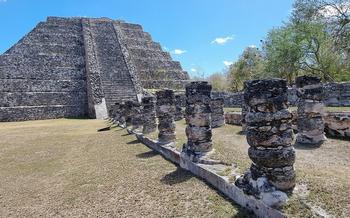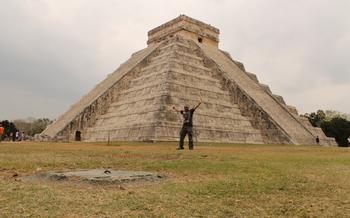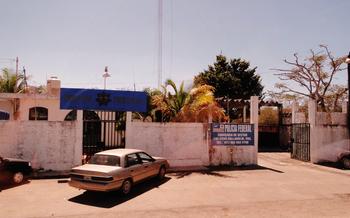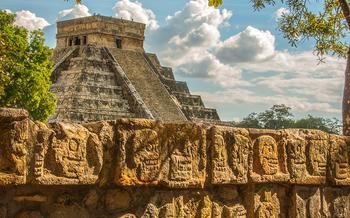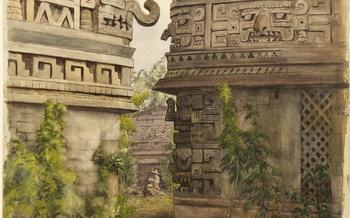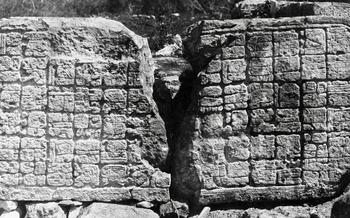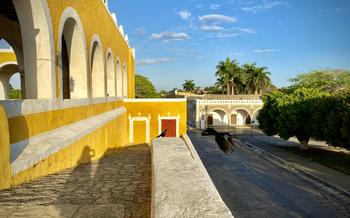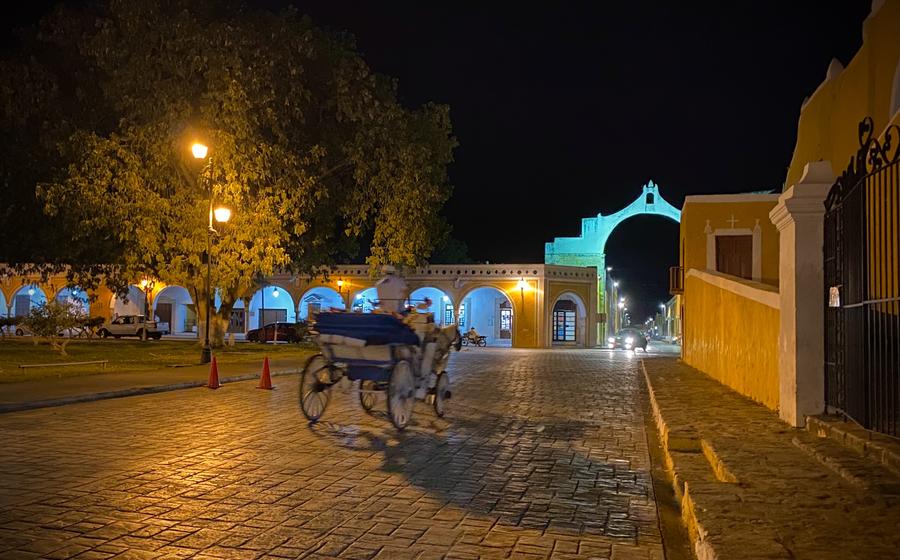
Mayapan Archaeological Zone (Nearby city)
- Mayapan Archaeological Zone: A Hidden Gem of the Yucatán Peninsula
- Exploring the Ruins: A Journey Through Time
- The Temple of Kukulcan: A Majestic Pyramid
- The Hall of Columns: A Silent Witness to History
- The Central Plaza: A Gathering Place of the Maya
- The Temple of the Warriors: A Symbol of Strength
- The Temple of the Masks: A Mysterious Sanctuary
- The Cenote Chichankanab: A Sacred Water Source
- The Museum of Mayapan: A Window into the Past
- Guided Tours: Unveiling the Secrets of Mayapan
- Photography Tips: Capturing the Essence of Mayapan
- Cultural Significance: The Legacy of the Maya
- Local Cuisine: A Taste of Yucatecan Flavors
- Souvenirs and Handicrafts: Taking Home a Piece of Mayapan
Mayapan Archaeological Zone: A Hidden Gem of the Yucatán Peninsula
Nestled deep within the lush Yucatán Peninsula, the Mayapan Archaeological Zone stands as a testament to the grandeur and ingenuity of the ancient Maya civilization. Once a thriving metropolis and the capital of the powerful League of Mayapán, this hidden gem offers a unique glimpse into the rich history and culture of the Maya people.
With its well-preserved ruins, intricate carvings, and fascinating legends, Mayapan invites travelers to embark on a journey through time. Located just a short distance from the charming colonial town of Izamal, this archaeological site is a must-visit destination for anyone seeking to delve into the depths of Maya civilization.
Whether you're a history buff, an architecture enthusiast, or simply a curious traveler, Mayapan has something to offer everyone. Prepare to be captivated by the grandeur of this ancient city and discover the secrets that lie within its crumbling walls.
Historical Significance
Mayapan's historical significance is undeniable. Founded around 1200 AD, it quickly rose to prominence as the capital of the League of Mayapán, a powerful alliance of Maya city-states that dominated the region for over two centuries. During this time, Mayapan served as a center of political, economic, and cultural power, influencing the lives of countless Maya people.
The city's strategic location along trade routes and its control over vital resources contributed to its rapid growth and prosperity. Mayapan became a bustling metropolis, home to a diverse population of Maya artisans, merchants, and nobles. Its influence extended far beyond its borders, shaping the cultural and political landscape of the Yucatán Peninsula.
Unique Features
One of the most striking features of Mayapan is its unique architectural style. Unlike other Maya cities, which are characterized by towering pyramids and elaborate palaces, Mayapan's buildings are generally smaller and more compact. This distinct style reflects the city's relatively late construction period and its emphasis on urban planning.
Another unique aspect of Mayapan is its extensive network of sacbeob, or ancient Maya causeways. These elevated roads connected Mayapan to other important cities and towns, facilitating trade, communication, and transportation throughout the region. The presence of these sacbeob is a testament to the advanced engineering skills of the Maya people.
Getting There
Reaching Mayapan from Izamal is a breeze. The archaeological site is located just 40 kilometers (25 miles) southeast of Izamal, easily accessible by car or taxi. The drive takes approximately 45 minutes, offering stunning views of the Yucatán countryside along the way.
For those without their own transportation, organized tours are readily available from Izamal. These tours typically include round-trip transportation, a guided tour of the ruins, and lunch. They provide a convenient and hassle-free way to explore Mayapan, especially for those short on time or unfamiliar with the area.
Best Time to Visit
The best time to visit Mayapan is during the dry season, which runs from November to April. During these months, the weather is generally sunny and dry, making for ideal conditions for exploring the ruins. The clear skies also offer excellent opportunities for photography.
It's important to note that Mayapan can get quite hot and humid during the day, especially during the summer months. If you're visiting during this time, be sure to wear light, loose-fitting clothing, sunscreen, and a hat. It's also a good idea to bring plenty of water to stay hydrated.
Exploring the Ruins: A Journey Through Time
The history of Mayapan and its importance: Mayapan was once the capital of the Maya civilization in the Yucatán Peninsula, and its ruins offer a glimpse into the grandeur and complexity of this ancient civilization. It was founded around 1200 AD and served as the political and economic center of the Maya region until its decline in the 15th century.
The main structures and their significance: The ruins of Mayapan are home to several impressive structures, each with its unique significance. The most notable is the Temple of Kukulcan, a massive pyramid that dominates the site and is similar in design to the famous pyramid at Chichén Itzá. Other important structures include the Hall of Columns, a vast hall with hundreds of columns, and the Temple of the Warriors, with its intricate carvings depicting fierce warriors.
The intricate carvings and sculptures: The ruins of Mayapan are adorned with intricate carvings and sculptures that offer insights into the Maya culture and beliefs. These carvings depict various deities, rulers, and scenes from daily life, providing a glimpse into the artistic and cultural achievements of the Maya civilization.
Tips for exploring the ruins: To make the most of your visit to the Mayapan Archaeological Zone, it's recommended to wear comfortable shoes suitable for walking on uneven ground. Bring water, sunscreen, and a hat to protect yourself from the sun. It's also a good idea to hire a guide to provide insights into the history and significance of the ruins.
The Temple of Kukulcan: A Majestic Pyramid
Amidst the ruins of Mayapan stands the majestic Temple of Kukulcan, a towering pyramid that commands attention and awe. Its architectural marvel is evident in its grand scale, precise construction, and intricate details. While smaller in size compared to its counterpart at Chichén Itzá, the Temple of Kukulcan in Mayapan holds its own unique charm and significance.
The temple's design showcases the advanced engineering skills of the Maya people. Built on a rectangular base, it rises in nine levels, each adorned with intricate moldings and carvings. The grand staircase on the western side leads to the summit, where a small temple once stood, offering breathtaking views of the surrounding landscape.
The pyramid's name derives from the Maya deity Kukulcan, also known as Quetzalcoatl in Aztec mythology. Kukulcan was a feathered serpent god associated with wind, rain, and agriculture, holding a revered position in Maya beliefs. The temple served as a sacred site for rituals, ceremonies, and offerings to honor this powerful deity.
Climbing the pyramid's steep steps is an unforgettable experience, offering a sense of accomplishment and reward. As you ascend, the ruins of Mayapan unfold before you, revealing the grandeur of this ancient city. The view from the top is simply breathtaking, allowing you to soak in the panoramic vistas and appreciate the scale and layout of the entire site.
The Hall of Columns: A Silent Witness to History
Amidst the ruins of Mayapan stands the Hall of Columns, a testament to the grandeur and architectural prowess of the ancient Maya civilization. This impressive structure, comprising over 200 columns arranged in four rows, once served as a gathering place for religious ceremonies and public events. Its massive pillars, each adorned with intricate carvings and bas-reliefs, narrate the stories of Maya gods, rulers, and everyday life.
As you wander through the Hall of Columns, you can almost hear the echoes of the past, imagining the Maya people congregating here for important rituals and celebrations. The intricate carvings depict scenes of warfare, religious ceremonies, and agricultural activities, offering a glimpse into the rich tapestry of Maya culture.
One of the most striking features of the Hall of Columns is its acoustics. When you stand in the center and clap your hands, the sound reverberates throughout the chamber, creating a haunting echo that transports you back in time. This acoustic phenomenon is believed to have played a significant role in Maya religious ceremonies, as the echoing sounds were thought to carry prayers and offerings to the heavens.
To fully appreciate the grandeur of the Hall of Columns, visit during the late afternoon when the setting sun casts long shadows across the ruins. As the golden light illuminates the intricate carvings, the Hall of Columns transforms into a magical place, inviting you to linger and soak in the beauty and tranquility of this ancient sanctuary.
The Central Plaza: A Gathering Place of the Maya
In the heart of the Mayapan Archaeological Zone, the Central Plaza stands as a testament to the city's grandeur and significance. Covering an impressive expanse, the plaza was once the bustling hub of Mayapan, where the Maya people congregated for social, religious, and political events.
The plaza is flanked by the imposing remains of temples, palaces, and other structures, each silently narrating the story of Mayapan's rich history. The ball court, a prominent feature of the plaza, speaks to the importance of the game in Maya culture. Here, the Maya showcased their athleticism and paid homage to their gods through this ritualistic sport.
As you wander through the Central Plaza, you can't help but feel a sense of history and tranquility enveloping you. The crumbling structures and the surrounding lush vegetation create a serene atmosphere, allowing you to contemplate the lives and traditions of the Maya people who once thrived here.
The Temple of the Warriors: A Symbol of Strength
Amidst the ruins of Mayapan stands the Temple of the Warriors, a testament to the military prowess and cultural significance of the ancient Maya civilization. This impressive structure, known in Spanish as the Templo de los Guerreros, is a symbol of strength and resilience, embodying the warrior spirit that once defined this great city.
The Temple of the Warriors is distinguished by its unique architectural features. Its façade is adorned with intricate carvings depicting fierce warriors engaged in battle, their faces contorted in expressions of determination and ferocity. These carvings not only serve as a reminder of the military prowess of the Maya but also provide valuable insights into their beliefs and customs.
The symbolism of the warriors depicted in the carvings is particularly noteworthy. These figures represent the elite soldiers who protected Mayapan and ensured its dominance in the region. Their presence on the temple's façade serves as a reminder of the importance of military strength in Maya society and the high esteem in which warriors were held.
The connection between the Temple of the Warriors and the military prowess of Mayapan is further reinforced by the presence of a large platform at the base of the temple. This platform is believed to have been used for military drills and ceremonies, further emphasizing the central role that the military played in Maya culture.
Climbing to the top of the Temple of the Warriors is a rewarding experience, offering breathtaking views of the surrounding ruins and the lush Yucatán landscape. From this vantage point, visitors can appreciate the sheer size and scale of Mayapan, as well as the strategic location that contributed to its rise as a powerful city-state.
The Temple of the Masks: A Mysterious Sanctuary
Among the many intriguing structures at Mayapan, the Temple of the Masks stands out for its unique features and enigmatic aura. Its most striking characteristic is the presence of numerous masks adorning the exterior walls, lending the temple an air of mystery and intrigue. These masks are believed to represent various Maya deities and mythological figures, each with its own significance and symbolism.
The placement of the masks is also notable, as they are arranged in rows and columns, creating a sense of order and symmetry. Some masks appear to be smiling, while others seem to have more somber expressions, adding to the enigmatic nature of the temple. The exact purpose of the Temple of the Masks remains a subject of debate among archaeologists and historians. Some believe it was a place of worship dedicated to a specific deity or deities, while others suggest it may have been used for ceremonial rituals or astronomical observations.
The eerie atmosphere that permeates the Temple of the Masks further enhances its mystique. The dimly lit interior, the intricate carvings and sculptures, and the sense of history that lingers in the air create a unique and unforgettable experience for visitors. The temple's enigmatic nature and the many questions that surround its purpose continue to captivate the imaginations of those who visit this ancient Maya site.
The Cenote Chichankanab: A Sacred Water Source
The Mayapan Archaeological Zone is home to a sacred cenote called Chichankanab, which holds a significant place in the history and culture of the Maya people. Located a short distance from the main ruins, this cenote was a vital source of water for the ancient city. It was also considered a sacred place, believed to be a portal to the underworld and a place of communication with the gods.
According to Maya mythology, cenotes were believed to be the entrance to Xibalba, the Maya underworld, and were often associated with the rain god Chaac. The Cenote Chichankanab was particularly important as it was believed to be the birthplace of the Maya hero twins Hunahpu and Xbalanque, who played a crucial role in Maya mythology.
Today, visitors can swim in the refreshing waters of the Cenote Chichankanab, which remains a popular spot for locals and tourists alike. The cenote is surrounded by lush vegetation and offers a tranquil oasis amidst the ancient ruins. However, it is important to remember the sacred nature of the site and to show respect when visiting.
The Museum of Mayapan: A Window into the Past
Situated within the confines of the archaeological zone, the Museum of Mayapan offers a profound insight into the captivating world of the ancient Maya civilization. Within its walls, a treasure trove of artifacts, meticulously curated, unveils the rich history and cultural heritage of this extraordinary people.
Journey through the captivating exhibits, where intricate pottery, adorned with vibrant hues and symbolic motifs, narrates tales of daily life and sacred rituals. Gaze upon exquisitely carved jade and obsidian ornaments, whispering secrets of artistry and craftsmanship. Discover the significance of intricate stelae, inscribed with hieroglyphs that unlock the mysteries of Maya chronology and governance.
Interactive displays and educational programs bring the past to life, inviting visitors to delve deeper into the Maya cosmos. Learn about their complex system of writing, their sophisticated calendar, and their profound understanding of astronomy. Engage with hands-on activities that provide a tangible connection to the Maya legacy.
The Museum of Mayapan stands as a testament to the enduring spirit of the Maya people. It is a place where the past and present converge, where history unfolds before your very eyes. Immerse yourself in the wisdom and artistry of a civilization that continues to inspire and captivate the world.
Guided Tours: Unveiling the Secrets of Mayapan
Joining a guided tour at Mayapan offers a wealth of benefits that enhance your exploration. Knowledgeable and experienced guides provide insights into the history, culture, and significance of the ruins, bringing the past to life. Guided tours typically cover the main structures, including the Temple of Kukulcan, the Hall of Columns, and the Central Plaza, explaining their functions and symbolic meanings. They also point out intricate details and carvings that might go unnoticed by visitors exploring on their own.
There are various types of tours available, catering to different interests and preferences. Some tours focus primarily on the history and architecture of Mayapan, while others incorporate elements of mythology, culture, and nature. Visitors can choose from group tours, which offer a social and interactive experience, or opt for private tours for a more personalized and in-depth exploration.
When selecting a tour, it's important to consider your interests, budget, and time constraints. Reading reviews and recommendations from previous travelers can help you choose a reputable and knowledgeable guide. Guided tours typically start from Izamal or nearby cities and include transportation to and from the archaeological site.
By joining a guided tour, you'll gain a deeper understanding of Mayapan and its significance, making your visit more enriching and memorable. The insights provided by experienced guides will help you connect with the past, appreciate the cultural heritage of the Maya people, and create lasting memories of your exploration.
Photography Tips: Capturing the Essence of Mayapan
Photography Tips: Capturing the Essence of Mayapan
The ruins of Mayapan offer a wealth of photographic opportunities, from the towering Temple of Kukulcan to the intricate carvings in the Hall of Columns. To capture the best shots, it is important to consider the following tips:
-
Golden Hour Magic: The best time of day for photography is during the golden hours, just after sunrise and just before sunset, when the light is warm and diffused, creating stunning shadows and highlights.
-
Camera Settings: Use a wide-angle lens to capture the grandeur of the ruins and a tripod to ensure sharp images, especially in low-light conditions.
-
Composition Techniques: Experiment with different angles and perspectives to create dynamic compositions. Look for leading lines, such as staircases or columns, to draw the viewer's eye into the image.
-
Respect the Site: Always be mindful of other visitors and avoid disturbing the peace and tranquility of the ruins. Respect the site by staying on designated paths and refraining from touching or climbing on the structures.
Cultural Significance: The Legacy of the Maya
Mayapan holds immense cultural significance as a testament to the rich heritage of the Maya civilization. It represents the culmination of over a thousand years of Maya history and showcases the cultural, social, and political achievements of this ancient society. The ruins provide a glimpse into the Maya's advanced knowledge of astronomy, architecture, mathematics, and writing. Mayapan's legacy extends beyond the physical structures, as it embodies the cultural traditions, beliefs, and practices of the Maya people. These traditions and beliefs, deeply rooted in the ancient Maya worldview, continue to influence contemporary Maya communities and shape the cultural identity of the Yucatán region.
The Maya civilization flourished for over two thousand years, leaving an indelible mark on the history and culture of Mesoamerica. Mayapan, as one of the most prominent Maya city-states, played a crucial role in shaping this legacy. The city's strategic location facilitated trade and cultural exchange, resulting in a blend of influences from different Maya regions. This cultural melting pot gave rise to unique artistic styles, architectural innovations, and religious practices that set Mayapan apart from other Maya centers.
Preserving and protecting Maya heritage is of paramount importance to ensure that future generations can appreciate and learn from this extraordinary civilization. Archaeological research, restoration projects, and educational initiatives contribute to the safeguarding of Maya cultural heritage. By understanding and respecting the legacy of the Maya, we can foster a deeper appreciation for the cultural diversity that enriches our world.
Local Cuisine: A Taste of Yucatecan Flavors
The vibrant flavors of Yucatecan cuisine are a delightful fusion of Maya traditions and Spanish influences. Cochinita pibil, a slow-roasted pork dish cooked in banana leaves, is a must-try. Savor the rich flavors of panuchos, fried tortillas topped with beans, cochinita pibil, and pickled onions. Salbutes, similar to panuchos, are topped with turkey or chicken.
For a refreshing drink, indulge in a glass of horchata, a sweet beverage made with rice, cinnamon, and vanilla. End your meal with a slice of marquesita, a crispy crepe filled with Edam cheese and drizzled with condensed milk.
Discover the culinary delights of Izamal at local restaurants like Kinich, La Quinta Izamal, and El Patio. These establishments offer authentic Yucatecan dishes, allowing you to experience the region's culinary heritage firsthand.
Supporting local businesses is crucial for preserving the cultural traditions and flavors of Izamal. By dining at local restaurants and purchasing souvenirs from local artisans, you contribute to the economic well-being of the community.
Souvenirs and Handicrafts: Taking Home a Piece of Mayapan
As you explore the ruins of Mayapan, you'll likely be drawn to the vibrant colors and intricate designs of the traditional Maya handicrafts. From colorful woven textiles and intricate pottery to hand-carved wooden figurines and delicate jewelry, there's a wide variety of souvenirs to choose from. By purchasing these unique items, you not only take home a piece of Mayapan but also support the local artisans who keep these traditions alive.
To find authentic Maya handicrafts, head to the shops and stalls in and around the village of Izamal. Here, you'll find a wide selection of items made by local artisans using traditional techniques passed down through generations. Be sure to look for the "Hecho en México" (Made in Mexico) label to ensure you're getting genuine products.
When bargaining for souvenirs, be respectful and fair. Remember that these handmade items represent the livelihood of the artisans. It's important to support their work and ensure they receive a fair wage for their skills and craftsmanship. By doing so, you contribute to the preservation of Maya culture and traditions.
Whether you choose a colorful woven blanket, a hand-painted ceramic bowl, or a intricately carved wooden figurine, your souvenir from Mayapan will serve as a lasting reminder of your visit to this ancient city. It will not only beautify your home but also carry the spirit and history of the Maya people.

